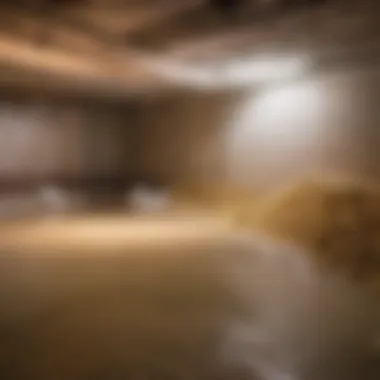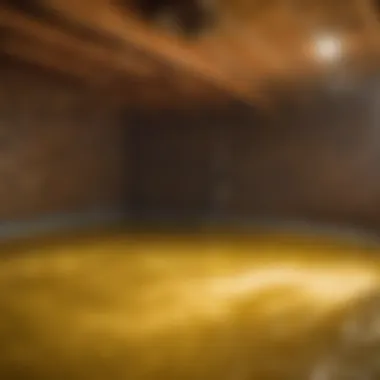Materials:
- Waterproofing membrane: 100 ft x 6 ft
- Foundation sealant: 5 gallons
- Drainage tiles: 50 ft
- Sump pump: 1 unit
- Backer rod: 100 ft
- Hydraulic cement: 2 bags
DIY Steps:
- Begin by thoroughly cleaning the basement walls to remove any dirt or debris.
- Apply the foundation sealant to all visible cracks and gaps in the walls using a caulk gun.
- Install the waterproofing membrane by cutting it to size and adhering it to the walls with a heavy-duty adhesive.
- Place the drainage tiles at the base of the walls to redirect water away from the foundation.
- Install the sump pump in the lowest point of the basement to pump out any accumulated water.
- Seal any remaining gaps with backer rod and hydraulic cement for added protection.
Technical Aspects:
- Tools required: caulk gun, utility knife, trowel, adhesive applicator
- Timing specifics: Allow 24 hours for the foundation sealant to dry before applying the waterproofing membrane
- Critical techniques: Avoid wrinkles when installing the membrane, ensure proper slope for drainage tiles
DIY Project Process:
- Start by cleaning the walls and applying foundation sealant as a base layer of protection.
- Carefully apply the waterproofing membrane, ensuring a tight seal to prevent water seepage.
- Install the drainage tiles along the perimeter of the basement, connecting them to the sump pump.
- Test the sump pump to ensure proper functionality and drainage capacity.
- Complete the project by sealing any remaining gaps with backer rod and hydraulic cement.
Troubleshooting Tips:


- If the waterproofing membrane is not adhering properly, consider using additional adhesive or consulting a professional for guidance.
- In case of water accumulation around the sump pump, check for clogs in the drainage system and ensure proper maintenance.
Understanding Basement Waterproofing Costs


In the realm of home maintenance and renovation, understanding the cost aspects of basement waterproofing is crucial. Not only does it directly impact the structural integrity and longevity of a property, but it also plays a significant role in the overall comfort and safety of its inhabitants. This section of the article serves as a comprehensive guide, shedding light on the intricate details and considerations associated with basement waterproofing costs.
Factors Influencing Waterproofing Costs
Ingress Points and Severity of Water Damage
When assessing basement waterproofing costs, one key factor that significantly influences the expenses is the presence of ingress points and the severity of water damage. Ingress points refer to the areas where water can enter the basement, such as cracks in the walls or foundation. The severity of water damage determines the extent of repairs and waterproofing required, impacting the overall cost.
Basement Size and Layout
The size and layout of a basement are essential factors to consider when calculating waterproofing costs. A larger basement with intricate layouts may require more materials and labor, increasing the overall expenses. The layout complexity can pose challenges during the waterproofing process, adding to the time and cost involved in effectively sealing the basement.
Type of Waterproofing Method Chosen
The choice of waterproofing method significantly affects the total cost of basement waterproofing. Different methods, such as internal sealants, external membranes, or drainage systems, come at varying price points. Each method has its unique characteristics and suitability based on the specific requirements of the basement, influencing both the upfront and long-term expenses.
Initial Inspection and Assessment
Completing a thorough initial inspection and assessment is a critical step in understanding the waterproofing needs of a basement. By hiring professional inspectors, homeowners can gain valuable insights into the current state of the basement, identifying potential problem areas and waterproofing requirements.
Hiring Professional Inspectors
Professional inspectors bring expertise and experience to the table, allowing homeowners to receive a detailed evaluation of their basement's waterproofing needs. From identifying hidden leaks to assessing structural vulnerabilities, inspectors play a crucial role in formulating an effective waterproofing plan tailored to the specific demands of the property.
Identifying Waterproofing Needs
Identifying specific waterproofing needs involves a detailed analysis of the basement's vulnerabilities and susceptibilities to water intrusion. This process helps homeowners understand the required waterproofing measures, whether it involves repairing existing damage, installing drainage systems, or applying protective coatings. By accurately identifying these needs, homeowners can develop a targeted and cost-effective waterproofing strategy.
Common Techniques for Waterproofing Basements


In this comprehensive guide about the cost of waterproofing your basement, understanding the common techniques for waterproofing basements is crucial. These techniques play a vital role in ensuring the structural integrity and longevity of your basement against water intrusion. By exploring these methods, homeowners can make informed decisions regarding the best approach for their specific needs.
Interior Waterproofing Methods
When it comes to interior waterproofing methods, two prominent techniques stand out: Epoxy Injection and Interior Drainage Systems.
Epoxy Injection
Epoxy injection is a specialized technique used to repair cracks in basement walls caused by water seepage. This method involves injecting epoxy directly into the cracks to create a waterproof seal, effectively preventing further water infiltration. One of the key characteristics of epoxy injection is its ability to provide a strong and durable barrier against water, ensuring long-lasting protection for your basement. Homeowners opt for epoxy injection due to its effectiveness in addressing specific areas of vulnerability and its seamless application process. However, it is essential to note that epoxy injection may have limitations in treating larger structural issues within the basement, requiring a thorough assessment by professionals.
Interior Drainage Systems
Interior drainage systems are designed to manage excess water inside the basement by directing it away from the foundation walls. These systems typically consist of a network of pipes and sump pumps that collect and redirect water towards a designated drainage area. The key advantage of interior drainage systems is their efficiency in preventing water buildup and alleviating hydrostatic pressure, thus reducing the risk of structural damage. Homeowners appreciate the discrete installation of interior drainage systems, as they do not alter the external appearance of the property. However, regular maintenance is essential to ensure optimal performance and prevent any clogging or malfunctions.
Exterior Waterproofing Methods
Exterior waterproofing methods are essential for safeguarding the foundation of your home against external water sources. Two common techniques utilized for exterior waterproofing are Excavation and Waterproof Coatings and French Drains.
Excavation and Waterproof Coatings
Excavation and waterproof coatings involve excavating the soil around the foundation to apply a waterproof membrane or coating on the exterior walls. This method creates a robust barrier that repels water and moisture from penetrating the foundation, thus preserving its structural integrity. The key characteristic of excavation and waterproof coatings is their comprehensive protection against a wide range of water intrusion issues, making them a popular choice for homeowners seeking durable solutions. However, the excavation process can be labor-intensive and costly, requiring professional expertise for precise application.
French Drains
French drains are perimeter drainage systems installed underground around the foundation to channel water away from the building. These drains consist of perforated pipes wrapped in gravel, allowing for efficient water collection and transportation to a designated drainage area. The unique feature of French drains lies in their ability to mitigate water pressure around the foundation, preventing moisture-related issues such as mold or foundation cracks. Homeowners opt for French drains due to their reliability in managing excess water and enhancing the overall waterproofing system. However, periodic inspection and maintenance are essential to ensure optimal functionality and prevent potential blockages.
This detailed exploration of common techniques for waterproofing basements equips homeowners with valuable insights to make informed decisions regarding their basement waterproofing needs. By understanding the benefits, considerations, and unique features of each method, individuals can effectively protect their homes from water damage and maintain a secure living environment.
Estimating the Cost of Basement Waterproofing
In this section of the article, we delve into the crucial aspect of estimating the cost of basement waterproofing. Understanding the cost involved in this process is essential for homeowners looking to protect their property from water damage and mold. By estimating the expenses accurately, individuals can plan their budget effectively and make informed decisions regarding the waterproofing methods best suited to their needs.
Cost Breakdown
Materials
When it comes to basement waterproofing, the choice of materials plays a significant role in determining the overall cost and effectiveness of the project. High-quality materials such as waterproof membranes, sealants, and drainage systems are essential for ensuring a durable and long-lasting waterproofing solution. These materials not only provide a barrier against water penetration but also contribute to the structural integrity of the basement. While the initial cost of premium materials may be higher, they offer superior protection and can prevent costly water damage in the future.
Labor
The labor cost associated with basement waterproofing involves the fees paid to professional contractors or waterproofing specialists for their services. Skilled labor is necessary for ensuring that the waterproofing techniques are implemented correctly and according to industry standards. Labor costs can vary depending on the complexity of the project, the duration of work required, and the expertise of the contractors. While hiring experienced professionals may increase the upfront cost, it can ultimately save money by preventing the need for repairs due to improper installation.
Additional Repairs
In addition to the core waterproofing materials and labor expenses, homeowners should also consider the potential need for additional repairs during the waterproofing process. These repairs may include fixing existing structural issues, addressing cracks in the foundation, or replacing damaged insulation. While these additional repairs can add to the total cost of waterproofing, addressing them proactively can prevent further damage and ensure the long-term effectiveness of the waterproofing solution.
Average Costs for Different Methods
Ballpark Figures for Interior Waterproofing
Interior waterproofing methods such as epoxy injection and interior drainage systems typically range in cost based on the extent of water damage and the size of the basement. The average cost of interior waterproofing can vary between a few hundred to several thousand dollars, depending on the chosen technique and the materials used. While interior waterproofing offers protection from water intrusion, it is essential to assess the specific needs of the basement to determine the most cost-effective and efficient method.
Estimated Expenses for Exterior Waterproofing
Exterior waterproofing methods like excavation and waterproof coatings, as well as French drains, require extensive labor and materials to excavate and seal the foundation from the outside. The estimated expenses for exterior waterproofing can range from several thousand to tens of thousands of dollars, depending on the complexity of the project and the size of the property. While exterior waterproofing is a more comprehensive solution that addresses the underlying cause of water intrusion, it is crucial to consider both the cost and long-term benefits when selecting the appropriate waterproofing method for your basement.
Budgeting and Financing Options
In the realm of waterproofing your basement, one of the crucial aspects that need meticulous consideration is budgeting and financing options. It plays a pivotal role in the overall process, ensuring that you have a clear financial plan to execute the waterproofing effectively and efficiently. Understanding the specific elements of budgeting and financing options can significantly impact the success of your waterproofing project.
Creating a Waterproofing Budget
Allocating Funds for Waterproofing: A Key Decisive Factor
Allocating funds for waterproofing is a strategic move that requires detailed planning and foresight. By earmarking specific amounts for materials, labor, and additional repairs, you can streamline the budgeting process and prevent overspending. This proactive approach ensures that every aspect of the waterproofing project is covered, leaving no room for financial uncertainties or budget constraints. The key characteristic of allocating funds for waterproofing is its ability to provide a structured financial framework, allowing you to track expenses and make informed decisions throughout the project. This method is a popular choice for those seeking financial clarity and transparency, as it promotes fiscal responsibility and cost-effectiveness. However, it is essential to note that allocating funds for waterproofing requires thorough research and cost evaluations to ensure that every aspect of the project is adequately funded.
Considering Long-Term Investments: Securing Your Basement's Future
When considering long-term investments in waterproofing, you are not just focusing on the immediate costs but also future-proofing your basement against potential water damage. This forward-thinking approach involves investing in high-quality materials and professional services that can withstand the test of time, ensuring long-term protection for your property. The key characteristic of long-term investments in waterproofing is their ability to provide lasting benefits and savings by mitigating the need for frequent repairs or replacements. This approach is a wise choice for homeowners who prioritize durability and longevity, as it reflects a proactive stance towards maintaining a dry and secure basement. Despite its advantages, long-term investments may require a higher initial investment; however, the return on investment in terms of peace of mind and property value protection makes it a worthwhile consideration.
Financing Solutions
Home Improvement Loans: A Path to Enhanced Property Value
Home improvement loans offer homeowners a viable financial solution to fund their waterproofing projects. The key characteristic of home improvement loans is their accessibility and flexibility, allowing individuals to secure necessary funds without draining their savings. This option is popular among homeowners looking to enhance their property value and address maintenance issues effectively. The unique feature of home improvement loans lies in their ability to provide fixed or variable interest rates, tailored repayment terms, and minimal upfront costs, making them a convenient financing option for waterproofing projects. Despite their advantages, it is essential to weigh the potential drawbacks, such as interest rates and loan terms, to make an informed decision that aligns with your financial goals and capabilities.
Payment Plans with Contractors: Collaborative Financing for Seamless Execution
Engaging in payment plans with contractors offers homeowners a structured approach to financing their waterproofing endeavors. This payment arrangement allows for phased payments based on project milestones, ensuring financial transparency and accountability throughout the process. The key characteristic of payment plans with contractors is their collaborative nature, fostering a relationship of trust and mutual commitment between homeowners and service providers. This option is beneficial for individuals seeking a tailored financial arrangement that aligns with their budget constraints and project scope. The unique feature of payment plans with contractors is their ability to facilitate a seamless execution of waterproofing projects while maintaining financial stability and control. It is essential to consider the advantages, such as payment flexibility and project milestone-linked payments, against potential disadvantages like contractual obligations and payment deadlines to make an informed choice that suits your financial preferences and project requirements.
Factors Affecting the Overall Cost
When considering the comprehensive guide to the cost of waterproofing your basement, it is essential to delve into the factors that influence the overall cost. Understanding the intricacies of what affects the expenses involved in basement waterproofing allows homeowners to make informed decisions. By exploring the different elements that contribute to the overall cost, individuals can better budget and plan for this significant home improvement project.
Factors such as geographical location and unexpected repairs play a crucial role in determining the total expenses incurred during basement waterproofing. By acknowledging and analyzing these aspects, homeowners can anticipate and address potential cost variations effectively, ensuring a smoother and more controlled waterproofing process.
Geographical Location
Regional Price Variations
Regional price variations are a key aspect that significantly impacts the overall cost of basement waterproofing. Different regions may have varying price structures for materials, labor, and additional repairs. This variation is often influenced by the availability of resources, local market conditions, and geographical factors.
In the context of this article, understanding regional price variations allows homeowners to assess the potential cost differences based on their location. By exploring how prices vary across different regions, individuals can gain insights into budget adjustments and resource allocation for their waterproofing project.
Regional price variations offer both advantages and disadvantages. While certain regions may have access to cost-effective materials, others might face higher labor expenses. Acknowledging these differences helps homeowners tailor their waterproofing plans to align with their budget constraints and financial expectations.
Emergency Repairs and Unforeseen Costs
Dealing with Sudden Water Intrusion
Dealing with sudden water intrusion is a critical aspect that can significantly affect the overall cost of waterproofing a basement. Unexpected repairs and unforeseen water damages may necessitate immediate attention, leading to additional expenses beyond the initial budget.
In the scope of this article, addressing emergency repairs and unforeseen costs underscores the importance of having contingency plans in place. By preparing for sudden water intrusion scenarios, homeowners can mitigate financial risks and ensure a more comprehensive approach to basement waterproofing.
The unique feature of dealing with sudden water intrusion lies in its ability to test the preparedness and resilience of homeowners during the waterproofing process. While such unforeseen circumstances may pose challenges, effectively managing sudden water issues can lead to enhanced durability and long-term waterproofing success.





